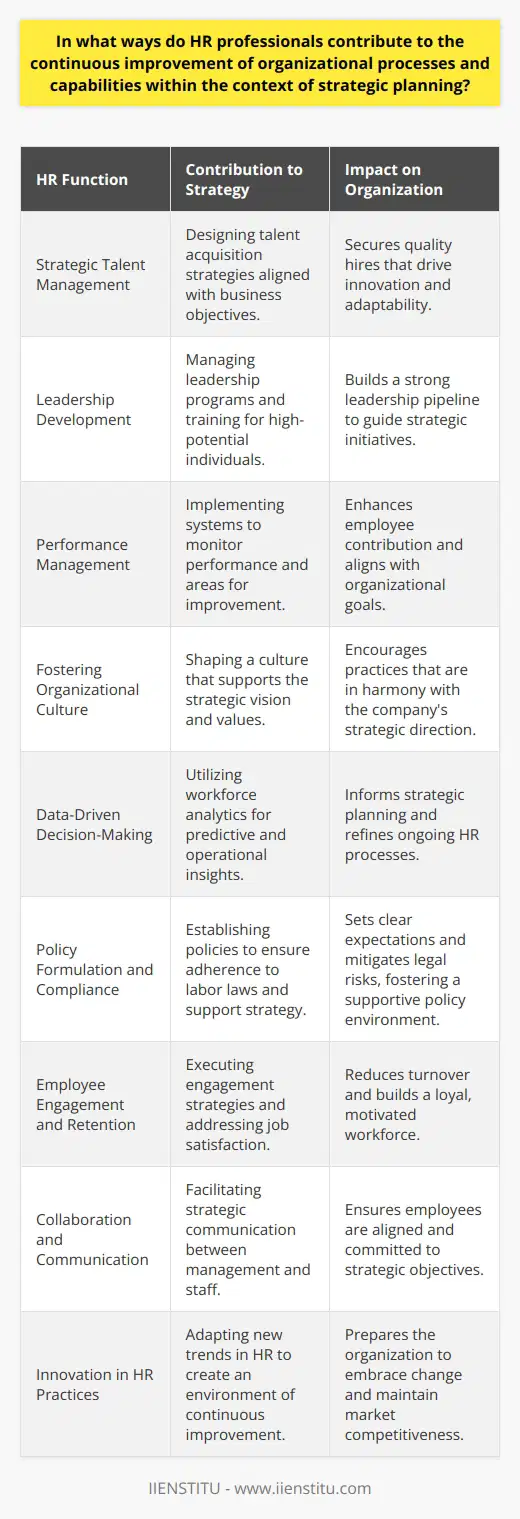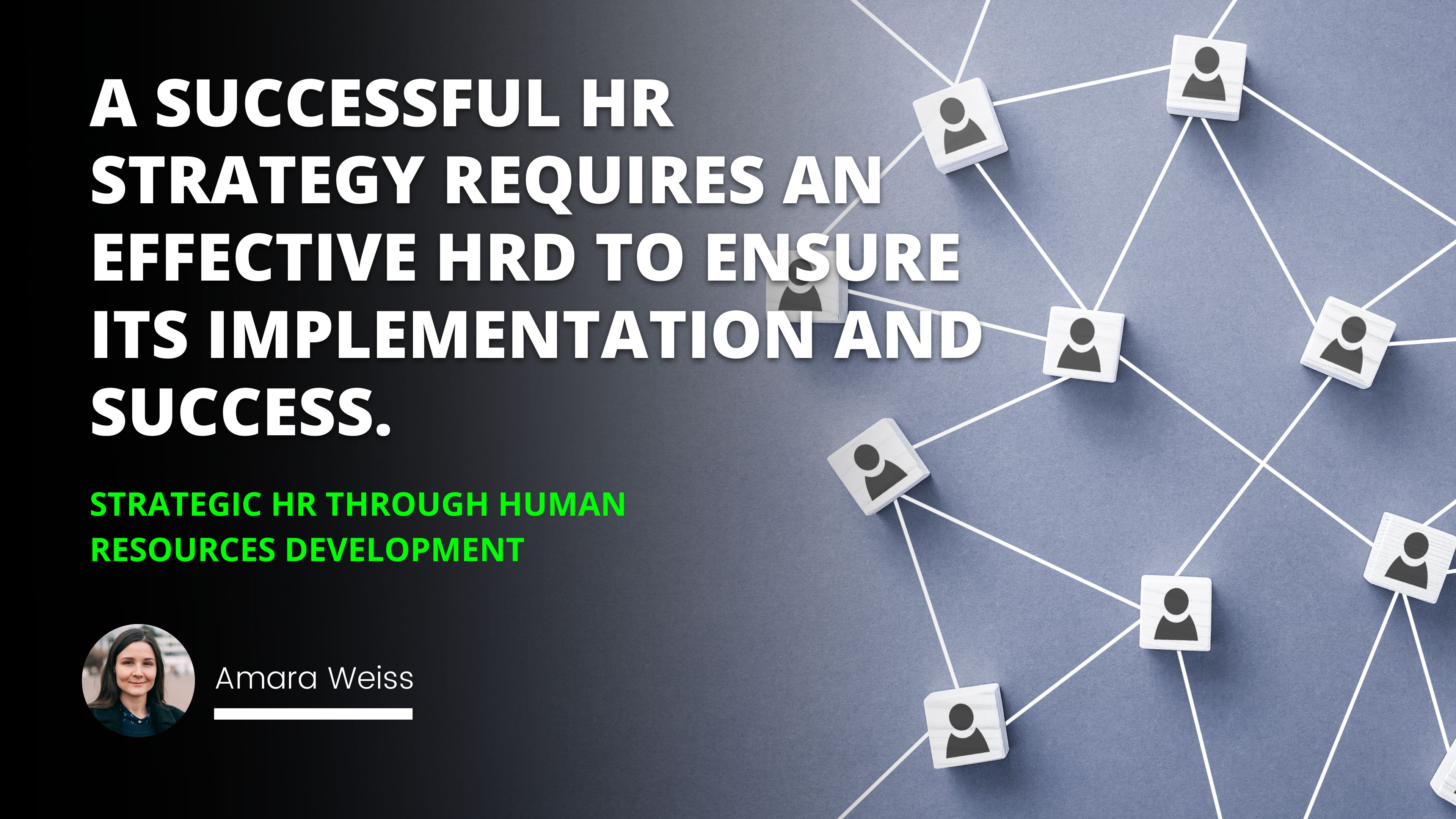
Strategic workforce planning is a process that involves the assessment of an organization’s current and future human resource needs and the development of strategies to meet those needs. Corporate HR plays a crucial role in strategic workforce planning, as it provides the necessary guidance and support to ensure that the organization’s human resources are effectively managed and utilized.
Strategic workforce planning has several benefits for an organization, such as ensuring that it has the right people with the right skills in the right place at the right time, ensuring that its recruitment and retention strategies are effective, and that its training and development strategies are in alignment with the organization’s strategic goals and objectives.
Strategic workforce planning aligns an organization’s human resources with its strategic goals and objectives. Corporate HR plays a vital role in this process, providing guidance and support to ensure that the organization’s human resources are effectively managed and utilized.
Benefits of strategic workforce planning include having the right people with the right skills in the right place at the right time and ensuring that recruitment and retention strategies are effective and that training and development strategies align with the organization’s strategic goals and objectives.
Introduction
What is Strategic Manpower Planning?
The Role of Corporate HR in Strategic Manpower Planning
Benefits of Strategic Manpower Planning
Conclusion
Introduction: Strategic workforce planning is the process of aligning the organization’s human resources with the organization’s strategic goals and objectives. It is a fundamental part of any successful business and critical to any organization’s overall strategy. Corporate Human Resources (HR) is crucial in strategic workforce planning. It provides the necessary guidance and support to ensure that the organization’s human resources are effectively managed and utilized. In this article, we will discuss what strategic workforce planning is, the role of corporate HR in strategic workforce planning, and the benefits of strategic workforce planning, and conclude with some key takeaways.
What is Strategic Manpower Planning?
Strategic workforce planning is a process that involves the assessment of an organization’s current and future human resource needs and the development of strategies to meet those needs. It consists of identifying the organization’s skills and competencies, assessing its current and future human resource needs, and developing strategies to meet those needs. It also involves the development of a recruitment and retention strategy to ensure that the right people are hired and retained and developing a training and development strategy to ensure that the organization’s employees are adequately trained and developed.
The Role of Corporate HR in Strategic Manpower Planning
The role of corporate HR in strategic workforce planning is to provide guidance and support to ensure that the organization’s human resources are effectively managed and utilized. Corporate HR is responsible for developing and implementing strategic workforce plans that align with the organization’s goals and objectives. Corporate HR is also responsible for developing and implementing recruitment and retention strategies, training and development strategies, and performance management strategies. Corporate HR is also responsible for ensuring that the organization’s human resource policies and procedures are in alignment with the organization’s strategic goals and objectives.
Benefits of Strategic Manpower Planning
Strategic workforce planning has several benefits for an organization. It helps the organization to ensure that it has the right people with the right skills in the right place at the right time. It also helps the organization to ensure that its human resources are effectively managed and utilized. Strategic workforce planning also helps the organization ensure that its recruitment and retention strategies are effective and that its training and development strategies align with its strategic goals and objectives. Finally, strategic workforce planning helps the organization ensure that its human resource policies and procedures align with its strategic goals and objectives.
Conclusion: Strategic workforce planning is critical to any organization’s overall strategy. Corporate HR plays a crucial role in strategic workforce planning, as it provides the necessary guidance and support to ensure that the organization’s human resources are effectively managed and utilized.
Strategic workforce planning has several benefits for an organization, including providing that it has the right people with the right skills in the right place at the right time, that its recruitment and retention strategies are effective, and that its human resource policies and procedures are in alignment with the organization’s strategic goals and objectives.
Corporate HR is the cornerstone of successful strategic workforce planning - without it, the structure will crumble.

Frequently Asked Questions
What are the key components of Strategic Manpower Planning?
Workforce planning is a process that organizations use to forecast their future workforce needs and to ensure the availability of the correct number of skilled people at the right time. The primary objective of strategic workforce planning is to maximize the organization's performance by ensuring that it has the correct number of people with the right skills in the right place at the right time. It involves forecasting the number and skills of personnel needed and then developing plans to acquire and retain them.
The critical components of strategic workforce planning include:
Analysis of Current Manpower: This involves analyzing the current workforce to identify areas where changes need to be made. It includes assessing the existing skills and competencies of the crew and determining how these fit into the organization's plans and objectives.
Forecasting Future Manpower Needs: Organizations use forecasting techniques to predict future workforce needs. This involves studying the current and future business environment, analyzing the organization's plans, and identifying the essential skills and competencies needed to achieve those plans.
Developing Strategies to Acquire and Retain the Right People: Once the organization's future workforce needs have been identified, it can develop strategies to acquire and retain the right people. This may include recruiting and selecting the right people, developing training programs, and creating incentives to motivate employees.
Evaluating Performance: To ensure that the organization's workforce plans are successful, it is essential to evaluate the performance of the workforce. This may include conducting employee surveys, assessing the effectiveness of the organization's training programs, and analyzing the success of recruitment and retention efforts.
By implementing strategic workforce planning, organizations can ensure that they have the correct number of people with the right skills in the right place at the right time. It is an essential part of any organization's overall strategy and can help to maximize the performance of the organization.

How does Corporate HR contribute to the success of Strategic Manpower Planning?
Corporate Human Resources (HR) plays a critical role in the success of Strategic Manpower Planning (SMP). The purpose of SMP is to help organizations anticipate and plan for their future needs in terms of human capital. HR is responsible for establishing a clear and effective SMP framework, ensuring the organization's objectives are met and the organization can respond quickly to the changing needs of the business.
Effective SMP requires HR to assess the current and future needs of the organization so that the organization can plan for the correct number of employees with the right skills and competencies. This involves forecasting the demand for human resources in the future, including the necessary skills to achieve the organization's objectives. HR also needs to assess the human resources supply by analyzing the current workforce and its capabilities. The goal is to ensure that the organization can meet its objectives without over or under-staffing.
Once the workforce needs are identified, HR must create a strategy to acquire, develop, and retain the right people. This includes creating job descriptions, recruiting and selecting suitable candidates, and developing practical training and development programs. HR must also ensure that the organization complies with relevant laws and regulations related to labor, diversity, and compensation.
Finally, HR must develop a system to monitor and evaluate the effectiveness of the SMP. This includes setting performance criteria and tracking the organization's progress against its goals. HR must also ensure that the organization is responding to changes in the business environment and making necessary adjustments to the SMP.
In summary, the role of Corporate HR in the success of SMP is critical. First, HR must assess the current and future needs of the organization, create a strategy to meet those needs, and develop a system to monitor and evaluate the effectiveness of the SMP. By doing so, HR can help ensure that the organization can meet its objectives and respond quickly to changing needs.

What are the potential challenges associated with Strategic Manpower Planning?
The strategic workforce planning process is a critical component of an organization's success, as it involves the systematic identification, assessment, and response to the needs of the organization's workforce. However, this process is also fraught with potential challenges, ranging from accurately predicting the organization's workforce needs to balance its goals with its employees' requirements. In this article, we will explore the potential challenges associated with strategic workforce planning and discuss possible solutions for addressing them.
The first potential challenge associated with strategic workforce planning is accurately predicting the organization's workforce needs. To succeed in this endeavor, an organization must be able to accurately forecast the future environment in which it will operate, as well as the skills and competencies required to meet its future goals. This can be challenging, as the future climate is often uncertain and difficult to predict. Additionally, the organization may not be aware of the new skills and competencies required to meet its future goals, making it difficult to plan for them accurately.
The second potential challenge associated with strategic workforce planning is balancing the organization's goals with its employees' needs. This can be a difficult task, as the organization's purposes are often focused on meeting its long-term objectives, while the needs of the employees may be focused on the short-term. Additionally, the organization must consider the potential impact of its decisions on employee morale and productivity, which can be challenging to predict.
Finally, implementing the strategic workforce plan can be a challenge in and of itself. Implementing the program may require changes to the organizational structure, which can be challenging to implement, and may result in resistance from employees. Additionally, the organization must ensure that its strategy is aligned with its core values and vision and that its personnel is adequately trained and equipped to meet the plan's goals.
To successfully address the potential challenges associated with strategic workforce planning, organizations must consider their environment and the competencies that their workforce will require in the future. Additionally, organizations must ensure that their goals are aligned with their employees' needs and that their strategies are communicated effectively to the workforce. Finally, organizations must ensure that their plan is implemented in a way that is both efficient and effective. By taking these steps, organizations can ensure that their strategic workforce planning process successfully meets their goals.
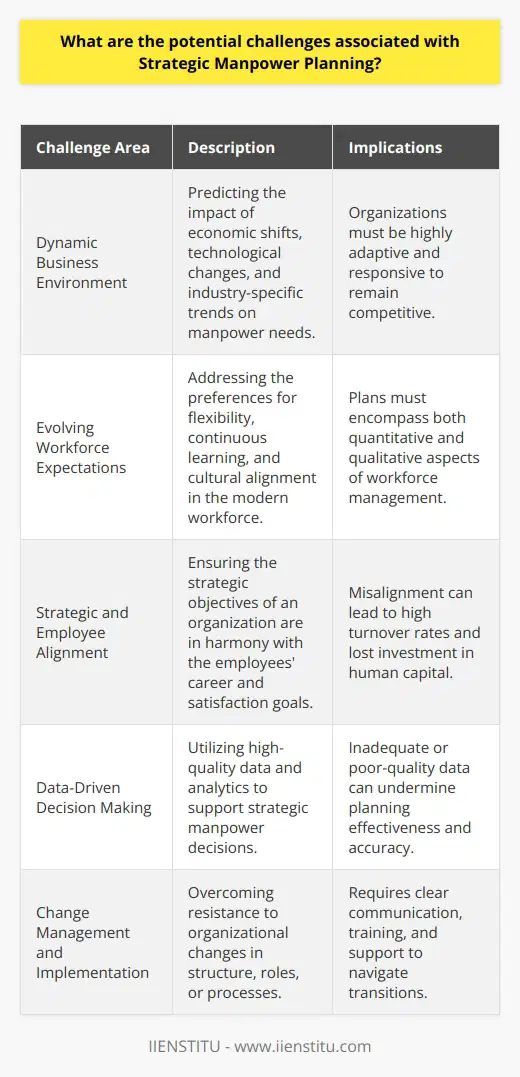
What is the role of HR in aligning organizational culture with strategic objectives?
The Role of HR in Aligning Organizational Culture and Strategy
Human Resources (HR) plays a pivotal role in aligning organizational culture with strategic objectives, as they are responsible for identifying, developing, and implementing policies and initiatives that support the company's vision, values, and goals. In this capacity, HR functions both as a guardian of the organizational culture and as a catalyst for positive change.
Recruitment and Selection
One of HR's primary responsibilities is to ensure that the organization recruits and selects individuals who match its cultural and strategic requirements. This involves developing and refining recruitment processes that focus on attracting candidates with the right mix of skills, experience, and cultural fit. By hiring candidates who embody the company's core values, HR helps to reinforce and strengthen the organizational culture.
Training and Development
HR also plays a crucial role in promoting a shared understanding of the organizational culture and strategic objectives among employees through training and development programs. These initiatives facilitate the acquisition of relevant skills and competencies, as well as the internalization of the organization's values and principles. As a result, employees become better equipped to contribute to the achievement of strategic goals and to uphold the cultural norms that define the company's identity.
Performance Management
Another key responsibility of HR lies in the implementation of effective performance management systems that enable employees' individual objectives to be aligned with the company's strategic goals. By providing consistent feedback, recognition, and coaching, HR helps to create a performance-driven culture that fosters employee engagement and commitment to the organization's mission and vision.
Organizational Communication
Establishing open and transparent communication channels is essential for promoting alignment between organizational culture and strategy. HR professionals are responsible for designing and implementing communication strategies that encourage dialogue and collaboration among employees and promote understanding of the company's strategic objectives. This, in turn, helps to create a shared sense of purpose and direction, fostering a cohesive and supportive work environment.
Change Management
Finally, HR plays a vital role in managing organizational change and ensuring that cultural shifts are in line with strategic objectives. Whether launching new initiatives, restructuring departments, or modifying existing processes, HR professionals are charged with facilitating a smooth transition, minimizing disruptions, and maintaining employee morale. By doing so, they ensure that the organization remains agile, resilient, and capable of adapting to evolving business landscapes.
In conclusion, the role of HR in aligning organizational culture with strategic objectives cannot be overstated. Through their involvement in recruitment, training and development, performance management, organizational communication, and change management, HR professionals contribute to creating a cohesive, performance-driven culture that supports the achievement of strategic goals and the organization's long-term success.
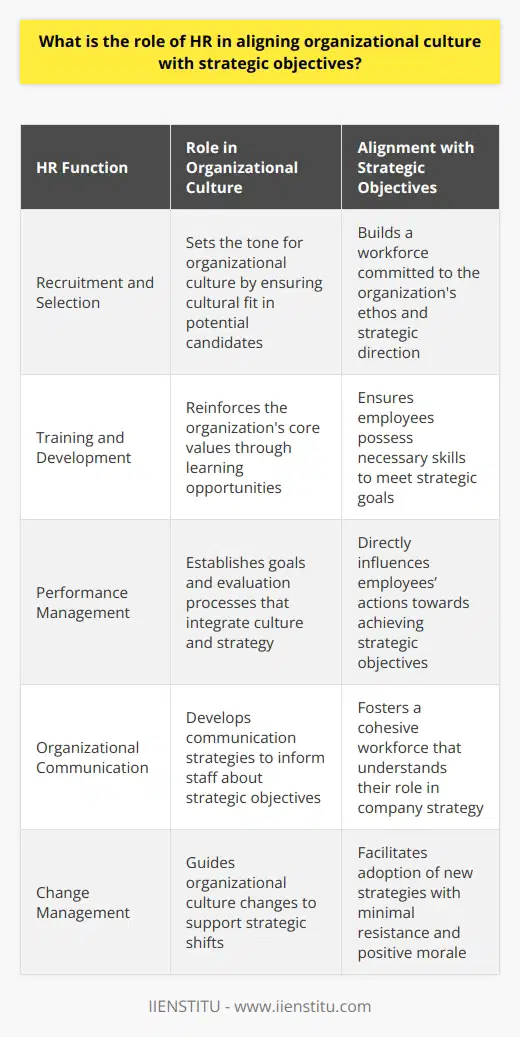
How do HR leaders determine the appropriate organizational structure in relation to overall workforce development?
**Assessing Organizational Needs**
To determine the appropriate organizational structure in relation to overall workforce development, HR leaders first identify their organization's strategic objectives and operational requirements. This involves a thorough analysis of the business model, objectives, market dynamics, and competitive landscape. By understanding an organization's current position and its long-term goals, HR leaders can make informed decisions about the required organizational structure.
**Evaluating Job Roles and Functions**
Next, HR leaders evaluate the various job roles and functions within the organization. They identify the core competencies needed for each role, as well as any skill gaps that may exist. This assessment helps HR leaders design job profiles and organize them into hierarchical structures or matrix-based alignments, depending on the organization's needs. Such an evaluation also ensures that the roles created align with the organization's workforce development objectives and growth strategy.
**Engaging Workforce Talent**
After determining an appropriate inrelation to overall workforce development, HR leaders need to engage their workforce effectively. This involves attracting and retaining the right talent, as well as developing employees' capabilities to adapt to future challenges. By aligning recruitment, performance evaluation, compensation, and career development processes with the proposed organizational structure, HR leaders can enhance overall workforce capabilities and productivity.
**Emphasizing Agility and Adaptability**
In today's rapidly evolving business environment, organizations must stay agile and adaptive. HR leaders play a vital role in fostering a culture of innovation, knowledge sharing, and continuous learning amongst employees. By promoting cross-functional collaboration and breaking down silos, HR leaders enable their workforce to adapt to changing market conditions, emerging technologies, and evolving organizational structures. This flexibility empowers the workforce to meet the demands of the digital age, contributing inrelation to overall workforce development.
**Monitoring Key Performance Indicators**
Finally, HR leaders track key performance indicators (KPIs) to ensure the implemented organizational structure yields the desired results regarding overall workforce development. These KPIs may include employee engagement scores, skill development metrics, attrition rate, and leadership pipeline health. Regular monitoring of these indicators enables HR leaders to fine-tune their approaches and make necessary adjustments to continually enhance the organization's effectiveness.
In conclusion, determining an appropriate inrelation to overall workforce development is a complex process that involves analyzing organizational needs, evaluating job roles and functions, engaging workforce talent, emphasizing agility and adaptability, and monitoring key performance indicators. By following these steps, HR leaders can create an environment that maximizes employee potential, driving organizational success and sustainable growth.

How does HR contribute to ethical decision-making within an organization's strategic planning process?
**Role of HR in Ethical Decision-Making**
Human resources (HR) plays a crucial role in promoting ethical decision-making within an organization's strategic planning process. HR ensures the formulation and implementation of policies reflecting the organization's core ethical values, guiding the behavior of employees and the overall company culture.
**Establishing Ethical Standards**
HR establishes ethical standards by creating codes of conduct, which provide employees with guidance on acceptable behavior and compliance with legal regulations. These standards act as benchmarks for evaluating and continuously improving an organization’s ethical performance.
**Training and Communication**
Through training and communication, HR raises awareness of organizational ethical values and the importance of ethical decision-making. HR professionals conduct workshops, seminars, and online courses to equip employees with the necessary tools and knowledge to make ethically sound decisions.
**Supporting Ethical Leadership**
HR supports ethical leadership within organizations by developing leadership programs that reinforce the importance of decision-making based on ethical principles. By fostering ethical leadership, HR helps create a culture where employees are more likely to make ethically sound decisions.
**Employee Performance and Evaluation**
HR contributes to ethical decision-making by incorporating ethical behavior as a key aspect in employee performance evaluations. Performance reviews and appraisals measure an employee's adherence to the organization's ethical standards, considering the ethical implications of their actions, and holding them accountable for lapses or violations.
**Handling Ethical Dilemmas**
HR professionals act as a trusted resource for employees facing ethical dilemmas, providing guidance and support in finding solutions aligned with the organization's values. By offering assistance in ethical decision-making, HR enhances the overall ethical culture of the organization.
**Continuous Improvement**
Continuous improvement of ethical performance is vital for an organization's long-term success. HR performs regular assessments of company ethical performance, gathering feedback from employees and stakeholders, and identifies areas for improvement. This allows the organization to remain proactive in addressing potential ethical challenges.
In conclusion, HR plays a critical role in ensuring ethical decision-making within an organization’s strategic planning process. By establishing ethical standards, providing training and communication, supporting ethical leadership, incorporating ethics in employee evaluations, and promoting continuous improvement, HR infuses the organization’s core values into everyday decision-making processes, leading to a more ethical and successful company.
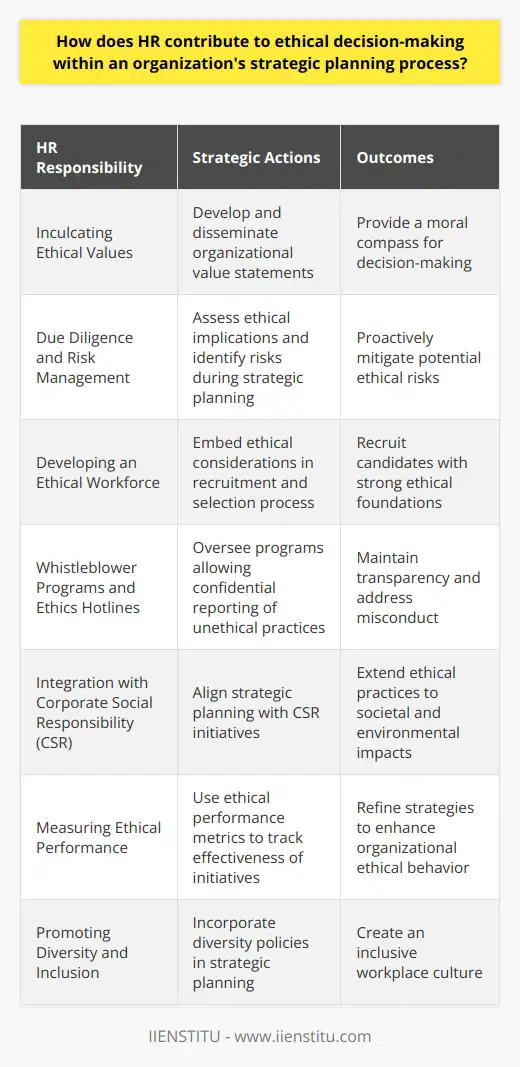
What is the role of HR strategy in aligning talent management with overall business goals?
The Role of HR Strategy in Alignment
A crucial aspect of an organization's success is the alignment of its talent management with its overall business objectives. Human Resource (HR) strategy plays a central role in facilitating this alignment, ensuring that the right talent is in place to drive business growth and achieve set goals.
Defining Strategic Objectives
To initiate the alignment process, HR professionals must have a solid understanding of the company's overall strategy and objectives. They must be aware of the organization's vision, mission, and core values, as well as its short and long-term goals. A thorough understanding of these aspects allows HR to tailor talent management initiatives accordingly and to prioritize efforts based on the significance of the business objectives.
Implementing Talent Management Practices
HR strategy is responsible for implementing talent management practices that align with the organization's strategic goals. These practices include talent acquisition, development, retention, and promotion of employees. The HR strategy should be flexible and adaptive to accommodate changing business priorities and should proactively address talent gaps or areas that require improvement.
Talent Acquisition and Retention
The recruitment and selection process forms a significant part of the HR strategy. Attracting the right talent that aligns with organizational goals begins with the creation of accurate job descriptions and clear role expectations. Thorough and well-executed selection techniques are essential in identifying candidates who possess the relevant skills, experience, and values that align with the company's objectives. Additionally, HR plays a vital role in fostering employee retention by developing competitive compensation and benefits packages and maintaining a positive work environment.
Employee Development and Succession Planning
HR professionals are responsible for ensuring that employees have the skills, knowledge, and capabilities necessary to meet the organization's strategic objectives. This involves a commitment to providing learning opportunities, training programs, and performance improvement interventions that align with business goals. It also requires that HR professionals implement effective succession planning processes to secure the continuity of vital roles within the organization.
Performance Management
A well-designed and executed performance management system is pivotal to supporting talent alignment with business priorities. HR strategy must encompass the establishment of clear performance expectations, regular employee feedback, and goal setting that is directly tied to the company's overall strategy. The performance management process should be both motivating and empowering for employees, enabling their development and continued alignment with the organization's objectives.
In conclusion, the role of HR strategy in aligning talent management with overall business goals is multifaceted and crucial to the success of the organization. By developing and implementing strategic and comprehensive talent management practices, HR professionals can effectively ensure that their organization's workforce is aligned, engaged, and equipped to contribute to achieving its strategic objectives.
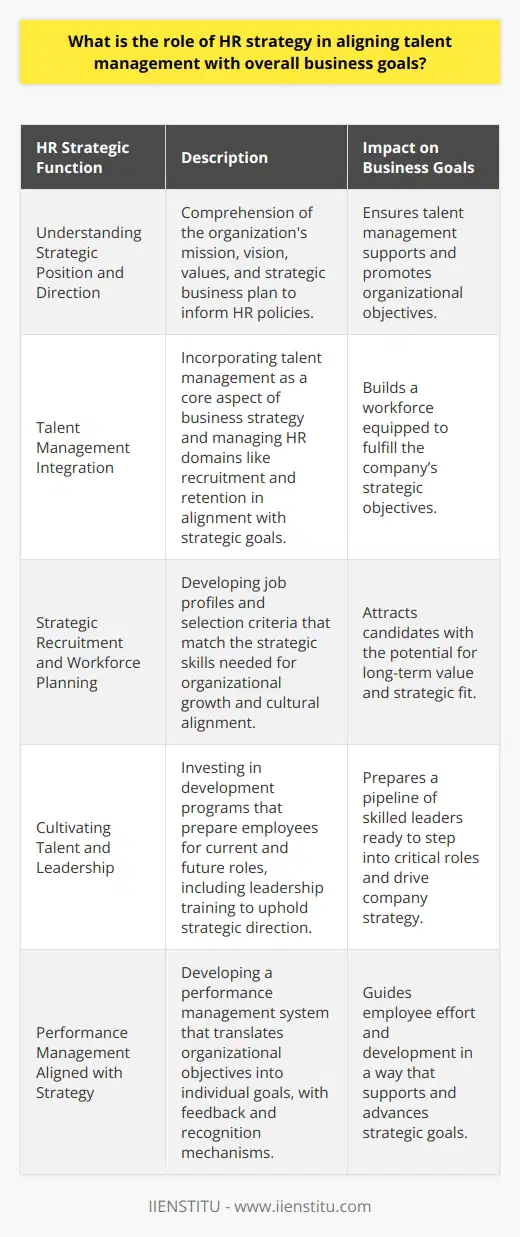
How do HR managers effectively implement succession planning in support of long-term strategic planning?
Understanding Organizational Goals
To effectively implement succession planning in support of long-term strategic planning, HR managers must first have a comprehensive understanding of the organization's goals and objectives. They can achieve this by collaborating with executives and managers to identify future leadership requirements based on the organization's strategic vision.
Identifying Internal Talent
HR managers should continually identify internal talent through performance reviews, training and development programs, and cross-functional work exposure. This process allows them to recognize individuals with high potential for leadership roles and groom them accordingly. It is essential for HR managers to keep an up-to-date and accurate database of employee skills, competencies, and career aspirations to facilitate talent identification.
Developing Succession Plans
Once internal talent has been identified, HR managers must develop succession plans that outline a clear path for the growth and development of these high-potential individuals. These plans should include targeted training, mentorship opportunities, and developmental job assignments aimed at preparing and challenging these employees for future leadership roles. Regular monitoring and evaluation of progress towards succession goals should also be conducted to ensure the effectiveness of the strategy.
Providing Opportunities for Growth
An integral part of succession planning is offering opportunities for high-potential employees to gain new skills and experiences, build their professional networks, and expand their understanding of business operations. HR managers can do this by creating rotational programs, offering specialized training, providing mentorship, and encouraging participation in external conferences or workshops.
Fostering a Supportive Culture
Lastly, HR managers play a critical role in fostering a supportive organizational culture that retains top talent and nurtures their growth. This can be achieved through processes such as performance management, employee recognition programs, and creating avenues for open dialogue and feedback. In addition, HR managers need to instill a culture of continuous learning, encouraging employees to develop their skills and to take responsibility for their career development.
In conclusion, implementing succession planning effectively in support of long-term strategic planning requires HR managers to understand organizational goals, identify and develop internal talent, create structured succession plans, provide opportunities for growth, and foster a supportive organizational culture. When executed well, it enables organizations to prepare leaders for future challenges and ensures business continuity.
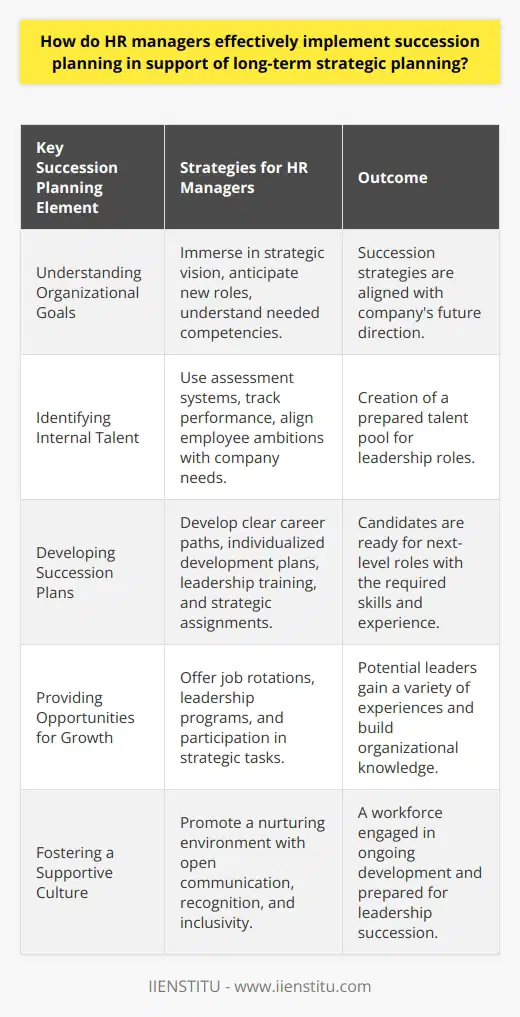
How can HR analytics contribute to informed decision-making within the strategic planning process?
HR Analytics in Strategic Planning
HR analytics, also known as people analytics, is a data-driven approach to human resource management that enables organizations to make informed decisions about their workforce. By leveraging statistical, computational, and data visualization techniques, HR analytics can contribute significantly to the strategic planning process in several ways.
Improved Workforce Planning
Firstly, HR analytics supports workforce planning by accurately forecasting future personnel needs. Analyzing historical workforce trends, employee performance data, and market conditions, HR professionals can develop data-driven hiring strategies that are aligned with business objectives.
Optimized Recruitment Strategies
Integrated HR analytics tools allow organizations to optimize their recruiting strategies by identifying talent gaps, assessing the effectiveness of recruitment channels, and understanding the characteristics of high-performing employees. With such insights, organizations can make targeted adjustments to their recruitment processes, ensuring they attract and secure the right talent for their business needs.
Enhanced Performance Management
HR analytics also plays a critical role in performance management, helping organizations to identify underperforming employees, analyze the factors driving poor performance, and develop appropriate interventions. By examining patterns and trends within employee performance data, leaders can improve the overall productivity and efficiency of their workforce.
Informed Workforce Development and Retention
Organizations can utilize HR analytics to support workforce development and employee retention initiatives. By analyzing employee turnover rates, skill gaps, and satisfaction data, organizations can strategically invest in training and development programs, implement targeted employee engagement initiatives, and fine-tune retention strategies to minimize attrition costs and preserve valuable human capital.
Data-Driven HR Policies and Processes
Finally, HR analytics can inform the development of data-driven HR policies and processes that are grounded in evidence, rather than intuition or anecdotal information. HR departments can use analytics insights to refine their approaches to compensation, benefits, work-life balance, and other relevant policies that directly impact workforce engagement, morale, and productivity.
In conclusion, HR analytics serves as a vital tool for informed decision-making within the strategic planning process, enabling organizations to optimize their talent management efforts and maximize their workforce's potential.

What is the role of HR in ensuring effective communication during the strategic planning process?
Role of HR in Effective Communication
Facilitating Collaboration between Departments
One of the main roles of human resources (HR) in ensuring effective communication during the strategic planning process is facilitating collaboration between various departments. HR ensures that all relevant stakeholders are involved in the discussions, providing their input, and sharing vital information to achieve the organization's objectives. This collaborative approach enables the development of a comprehensive and cohesive strategic plan that addresses critical aspects across different departments.
Identifying Necessary Training and Development
Moreover, HR plays a crucial role in identifying areas where employees may require additional training and skill development to effectively execute the strategic plan. By assessing the competencies and skills of the workforce, HR can recommend targeted employee development programs, ensuring that the organization has a competent team that can drive the implementation of strategic initiatives.
Ensuring Clear Communication Channels
Another essential function of HR in the strategic planning process is ensuring clear communication channels that enable uninterrupted information flow between organizational levels and departments. HR is responsible for implementing efficient communication tools that facilitate discussions, meetings, and feedback, ensuring that important information is disseminated promptly and that potential roadblocks are addressed in a timely fashion.
Managing Organizational Culture
The strategic planning process often involves changes in organizational culture to align with the new objectives and vision. HR plays a pivotal role in managing these changes, ensuring that employees understand the rationale behind the new directions and are motivated to support these initiatives. HR's effective communication in this context is critical for alleviating any resistance or concerns among employees and for fostering a culture of open dialogue, nurturing a collective sense of ownership and commitment towards the strategic plan.
Evaluating Communication Success
Finally, HR is instrumental in evaluating the success of communication efforts during the strategic planning process. By conducting regular assessments and gathering feedback from employees, HR can identify areas for improvement and adjust communication strategies accordingly to optimize the information exchange and ensure that the strategic planning process progresses efficiently.
In conclusion, the role of HR in ensuring effective communication during the strategic planning process is multifaceted. Facilitating collaboration between departments, identifying necessary training and development, ensuring clear communication channels, managing organizational culture, and evaluating communication success are among the main functions that HR executes to ensure efficient communication throughout the strategic planning process.
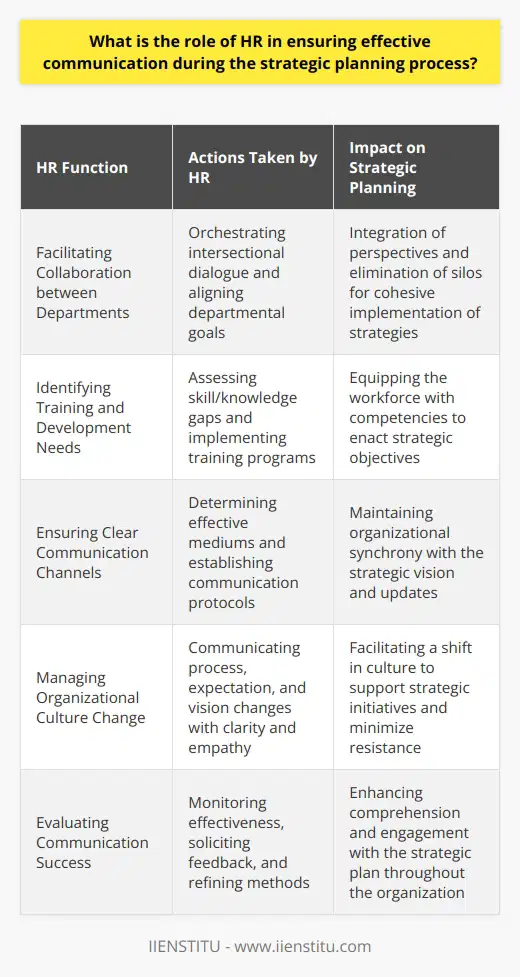
How does HR facilitate the alignment of individual performance goals with the overall strategic objectives of the company?
Role of HR in Goal Alignment
HR departments play a crucial role in facilitating the alignment of individual performance goals with the overall strategic objectives of the company. Through effective communication and employee engagement measures, HR ensures that employees understand the organization's priorities, mission, and values. This understanding creates a clear connection between individual tasks and larger strategic goals.
Developing Performance Metrics
One primary responsibility of HR is to develop performance metrics that accurately reflect the organization's strategic objectives. By designing metrics that assess employees' contributions to key performance indicators, HR empowers individuals to see how their work affects the broader objectives. This understanding promotes a positive work culture where employees feel motivated to perform at their highest potential.
Employee Training and Development
To support the alignment of individual performance goals with strategic objectives, HR must provide employees with opportunities to develop the skills necessary for their roles. This may include onboarding new employees, offering ongoing professional development, and creating leadership development programs for potential managers. By enabling employees to grow and excel in their positions, HR ensures that their performance aligns with the company's needs.
Performance Appraisal Systems
Another essential aspect of HR's role in goal alignment is the management of performance appraisal systems. These systems help link individual performance to strategic objectives by measuring employees' achievements against their goals and providing constructive feedback. Through regular performance reviews, employees can gain insights into their strengths and areas for improvement, ensuring their work aligns with the organization's larger goals.
Employee Engagement and Recognition
Finally, HR fosters alignment between individual goals and strategic objectives by promoting employee engagement and recognition. By acknowledging employees' hard work and expressing appreciation for their contributions, HR fuels motivation and commitment to the company's objectives. Moreover, through initiatives such as employee satisfaction surveys, HR can gather insights into the workforce's perspectives, enabling them to make informed decisions about programs and policies that support goal alignment.
In conclusion, HR acts as the bridge that connects individual performance goals to the overall strategic objectives of the company. By implementing measures that enhance communication, performance measurement, employee training, performance appraisal, and recognition, HR departments contribute to creating a unified and focused workforce dedicated to achieving the organization's long-term vision.

In what ways can HR contribute to the identification and management of risks during the strategic planning process?
**HR's Role in Risk Identification**
Human Resources (HR) plays a crucial role in identifying potential risks during the strategic planning process. Firstly, by evaluating the current workforce and their competencies, HR can highlight skill gaps that might hinder the achievement of strategic goals. This assessment allows the organization to take proactive measures by recruiting employees with the necessary skills or offering training and development opportunities to existing staff.
**Effective Communication Channels**
Another way HR contributes to risk management is by establishing effective communication channels within the organization. This involves promoting an organizational culture that encourages transparent and open dialogue. By fostering an environment where employees feel comfortable reporting potential issues and vulnerabilities, HR can ensure timely identification and mitigation of risks related to employee dissatisfaction, miscommunication, or non-compliance.
**Aligning Employee Performance**
Furthermore, HR can contribute to risk management by aligning employee performance with strategic objectives. By implementing performance management systems that evaluate employee performance in light of organizational goals, HR can ensure that employees understand their role in achieving those objectives. This reduces the risk of misaligned employee efforts, which could impede the accomplishment of strategic goals.
**Legal and Regulatory Compliance**
HR also takes part in managing risks by ensuring compliance with legal and regulatory requirements. This entails keeping abreast of relevant labor laws and regulations, monitoring the organization's adherence, and implementing necessary changes to avert non-compliance risks. Non-adherence to laws and regulations may result in fines, penalties, and reputational damage, thereby hindering the organization's strategic objectives.
**Succession Planning**
Lastly, HR contributes to risk management by developing succession plans for key leadership positions. This process involves identifying employees with the potential to assume senior positions, developing their skills, and gradually exposing them to leadership roles. Effective succession planning helps mitigate the risks associated with unexpected leadership departures or vacancies, ensuring the continuous execution and achievement of the organization's strategic objectives.
In conclusion, the HR function plays an integral part in identifying and managing risks during the strategic planning process. By evaluating workforce competencies, promoting effective communication, aligning employee performance, ensuring legal and regulatory compliance, and developing succession plans, HR helps organizations proactively address potential risks, paving the way toward the successful achievement of strategic objectives.
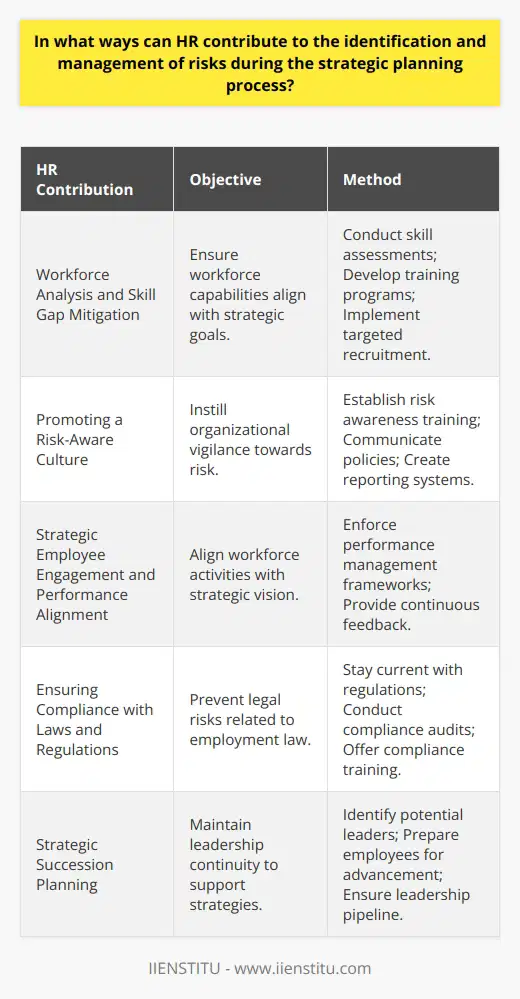
What is the role of HR in fostering innovation and adaptability within the strategic planning process?
Enhancing a Culture of Innovation
HR plays a critical role in promoting innovation within the strategic planning process. Through policies and programs, HR can encourage a culture that embraces creative thinking and the generation of novel ideas.
Employees' Skills and Capabilities Development
HR can also foster adaptability by focusing on the development of employees' skills and capabilities. Training, coaching, and continuous learning opportunities can equip individuals to respond proactively to emerging challenges and changing markets.
Integration of Innovation into Strategic Planning
Furthermore, HR can ensure that fostering innovation becomes an integral part of the strategic planning process. They can drive this by linking performance incentives to innovation metrics, working with senior leadership to establish innovation goals, and by holding individuals and teams accountable for reaching these targets.
Creating a Diverse Work Environment
Studies continue to show that diverse teams are more innovative. Therefore, HR plays a pivotal role in ensuring a diverse and inclusive work environment. By hiring individuals from different backgrounds and experiences, new perspectives can be gained, leading to innovative solutions.
Influencing Organizational Structure and Design
Finally, HR can influence how organizational structure and design enable or impede innovation. Flatter structures, where decision-making is decentralized, often promote better exchange of ideas and stimulate innovation.
Summary
In conclusion, HR impacts the strategic planning process by embedding innovation into the fabric of corporate culture, nurturing the development of adaptable employees, encouraging diversity, and influencing structural design to foster innovation. This underlines HR's pivotal role in a company's ability to remain competitive and adapt to an ever-changing business landscape.
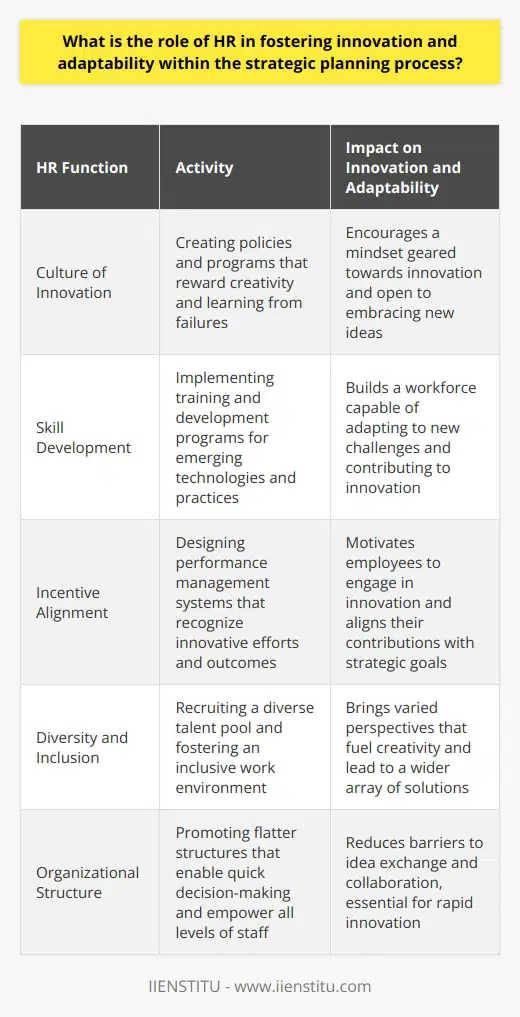
How do HR managers ensure the alignment of employee competencies and skills with the organization's strategic goals?
Key Strategies
HR managers follow various strategies to align employee skills and competencies with the company's strategic goals. Firstly, they identify the skill sets required in line with the organization's objectives. A thorough job analysis helps them pinpoint skills, knowledge, and abilities essential for each role.
Role of Training and Development
HR managers pay significant attention to training and development. These initiatives help employees to develop the necessary abilities and expertise for their roles. They design programs that are effective in building the skills needed to achieve strategic goals.
Importance of Performance Management
Next, they focus on performance management. They set specific, measurable, attainable, relevant, and time-bound (SMART) goals for each employee. Regular feedback and reviews ensure employees are on track.
Employee Recruitment and Selection
Recruitment and selection also play a pivotal role. HR managers recruit people who possess capabilities that align with the organization's strategy. They also ascertain that the selected candidates are a good cultural fit.
Implementing Succession Planning
Additionally, succession planning is a key strategy. HR ensures a supply of highly qualified individuals, equipped to take up leadership roles if required.
Value of Motivation and Incentives
Lastly, keeping employees motivated is fundamental. HR uses incentive schemes, recognizing and rewarding employees who contribute towards the achievement of strategic goals. This strategy reinforces the importance of aligning individual actions with organizational objectives.
In conclusion, HR managers use a holistic approach. They integrate various HR functions, activities, and instruments to ensure the alignment of employee competencies with organizational strategic goals. They create a dynamic environment that is oriented towards continuous learning, improvement, and achievement of strategic goals.
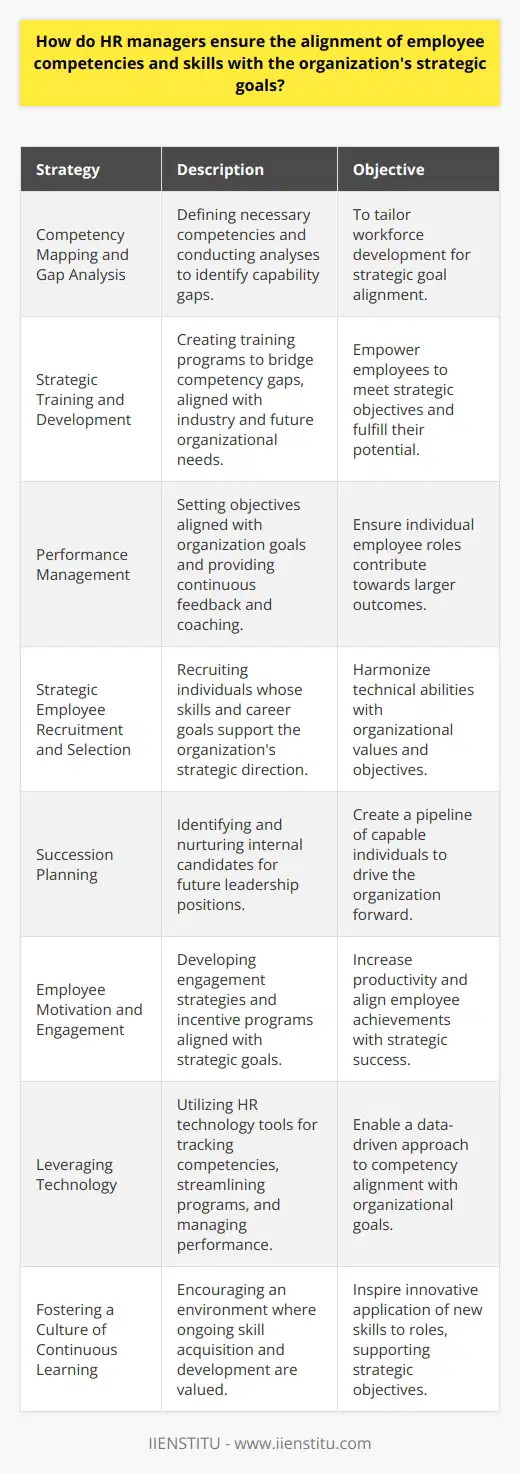
How can HR best support the integration of mergers and acquisitions within the overall strategic planning process?
Fostering an Inclusive Culture
To successfully integrate mergers and acquisitions (M&As), HR must foster an inclusive culture. This includes addressing cultural differences and establishing a common corporate identity. HR can contribute, by leading cross-cultural learning initiatives and fostering communication between diverse teams.
Alignment of Business Objectives
HR plays a critical role in harmonizing business objectives across different entities. They should align the strategic goals of the merged organizations by consistently communicating business strategies. This ensures everyone understands the new direction, making integration smoother.
Creating Strategic Partnerships
Establishing strategic partnerships with key stakeholders is crucial. HR needs to engage management, employees, and unions to ensure their buy-in. These partnerships aid in overcoming resistance to change, facilitating the merger process.
Managing Talent
Managing the talent pool effectively is another key area. HR must map out the skills within the merged entities and realign them with new strategic directions. Effective talent management can mitigate the risk of losing essential expertise during transitions.
Facilitating Smooth Transition
HR can further support M&As integration by facilitating smooth transitions. This involves open communication about changes, managing employee anxieties, and providing support where necessary. It's imperative to remember that employees are the backbone of any successful merger or acquisition.
In conclusion, HR plays a pivotal role in the successful integration of M&As. By fostering an inclusive culture, aligning business objectives, forming strategic partnerships, managing talent, and facilitating smooth transitions, HR can ensure the merger or acquisition aligns with the overall strategic planning process.
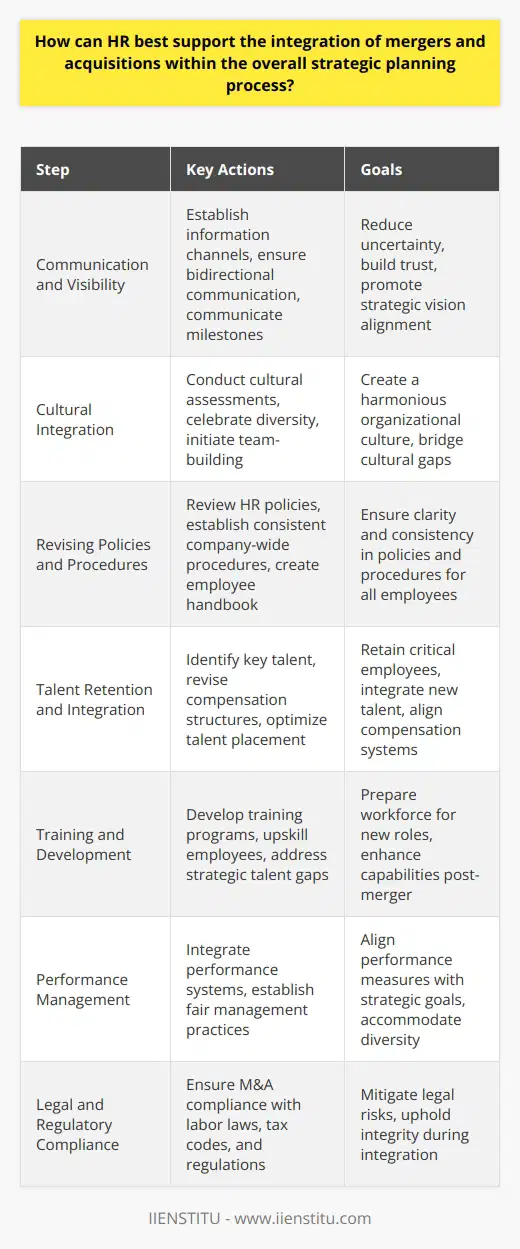
What is the role of HR in facilitating the development and execution of a company's strategic planning process?
Strategic Role of HR in Planning Process
The Human Resources (HR) department plays a crucial role in strategic planning within an organization. It involves aligning the company's workforce with its long-term business goals. HR forms the nexus among the company’s strategic goals, the employees, and the actions required to reach these goals.
Employee Preparation
Strategic planning begins with the company’s vision. HR establishes the skills and competencies required to meet this vision. They identify gaps in current employee skills and initiate talent acquisition or training programs.
Communicating Company Vision
Once HR identifies company goals, it must communicate them effectively. Clear communication ensures employees understand their roles in achieving these goals. HR relays the company's strategic vision, intending to generate employee buy-in and commitment.
Implementation and Monitoring
After communicating the vision, HR works on implementing strategic plans. They facilitate the development of organization-employee agreements. HR departments monitor progress, take corrective action when necessary, and report on the realization of strategic goals.
Workforce Advocacy
HR also safeguards the interests of employees as part of strategic planning. HR uses its understanding of corporate strategy and worker concerns to mediate between the two. By ensuring the workforce’s well-being, HR maintains employee morale and productivity which promotes the company’s strategic objectives.
In conclusion,
HR is not just a secondary operational function. It is an integral element in strategic planning, execution, and monitoring. HR balances corporate strategy with employee well-being, creating harmony that enables the organization to fulfill its strategic plans effectively.
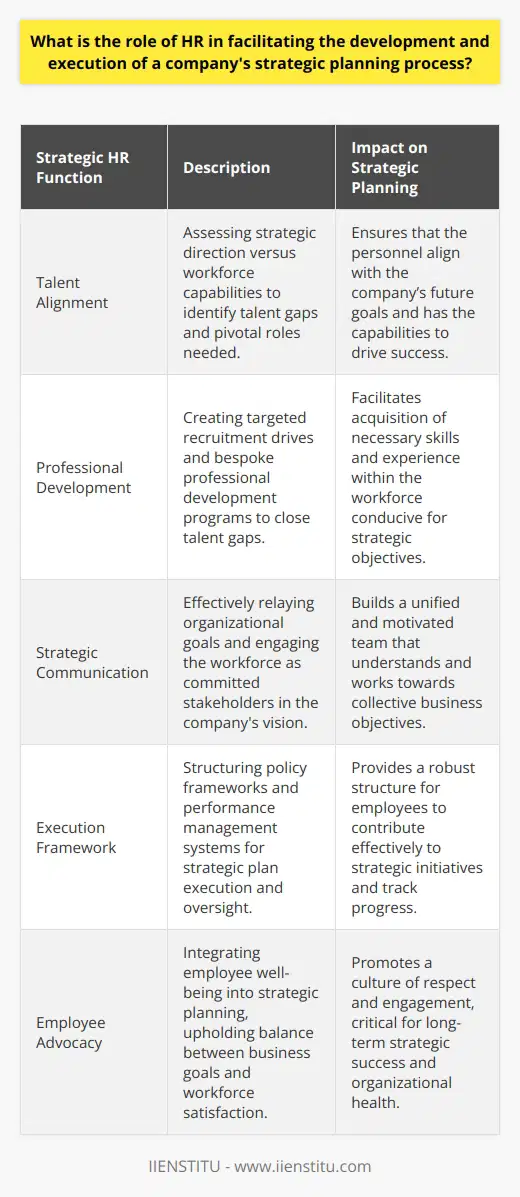
How does the HR manager contribute to the identification of current and future workforce needs in the context of strategic planning?
Identifying Current Workforce Needs
The HR manager plays a crucial role in identifying current workforce needs in the organization. They achieve this by conducting regular internal assessments and surveys. This process involves defining present job roles, necessary skills, and estimating manpower requirements.
Analyzing Skill Gaps
Once the HR manager identifies the existing skillset in the organization, they measure it against the required skills. This analysis identifies gaps and areas where the organization needs to invest in training or recruitment. The HR manager's role involves mapping out capabilities for present tasks and future growth based on strategic plans.
Estimating Future Workforce Requirements
An essential aspect of the HR manager’s role is estimating future workforce needs. They identify talent requirements aligned with the company's strategic plans and growth prospects. Their role involves forecasting future labour demands and planning for the same.
Recruitment and Retention Strategies
To meet the organization's current and future workforce requirements, the HR manager develops recruitment and retention strategies. They aim to attract skilled talent in a competitive labour market while promoting employee engagement and job satisfaction. This strategic approach helps to maintain a steady talent pipeline for the organization's ongoing and future needs.
Training and Development
Part of the HR manager's responsibility is focusing on employee training and development. They create programs to enhance employee skills and competencies. This execution ensures that employees are equipped to handle present roles and future responsibilities, thus enabling the organization to meet its strategic goals.
Succession Planning
Another responsibility of the HR manager in identifying future workforce needs involves succession planning. They determine potential leaders within the organization who can take up higher roles in the future. This action ensures long-term business continuity and success.
In conclusion, the HR manager's role is multi-faceted and dynamic. They contribute to identifying and meeting both current and future workforce needs using various techniques and strategic planning. Through their strategic input, they ensure that the organization is well-equipped to realize its potential and meet its strategic goals.
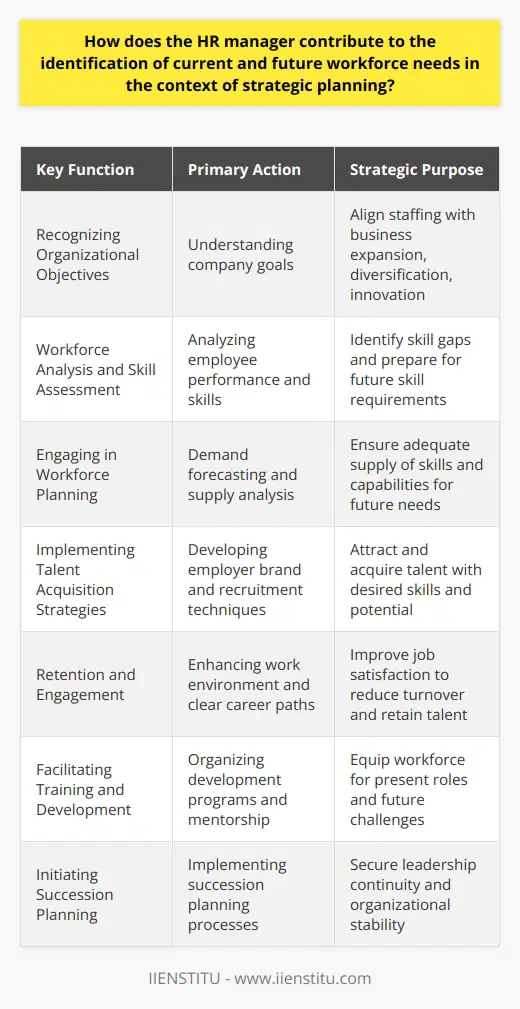
In what ways does the implementation of HR policies and practices influence the success of an organization's strategic plan?
Influence on Strategic Vision
HR policies and practices significantly impact the success of an organization's strategic plan.
Alignment with Organizational Goals
Essentially, a well-designed HR strategic plan ensures the alignment of human resources with the overall business plan. It envisions the future workforce requirements and develops strategies to meet these demands. Thus, it underpins the realization of business objectives.
Talent Acquisition and Retention
HR policies further affect an organization's strategy through talent acquisition and retention. Effective HR practices enhance recruitment procedures, employee engagement levels, and reduce attrition rates. Consequently, they secure and retain the skills and capabilities crucial for strategic success.
Development of a Positive Corporate Culture
HR policies also shape the organization's culture, a significant facet of the strategic plan. They foster a positive work environment that motivates employees, promotes creativity, and encourages teamwork. These virtue-columns lay the foundation for a strong corporate culture, instrumental to strategic accomplishment.
Employee Performance and Productivity
HR practices play a pivotal role in enhancing employee performance, a key success factor of strategic execution. This includes methods for managing performance, providing appropriate training, and rewarding excellence. By doing so, HR not only nurtures talent but also facilitates productivity which directly influences strategy attainment.
Risk Management
Lastly, HR policies aid in managing organizational risks that might deter strategic success. These encompass legal risks, such as non-compliance with labor laws, and operational risks, such as insufficient staffing. By mitigating these, HR practices ensure the smooth progress of strategic plans.
In conclusion, the implementation of HR policies and practices is a powerful mechanism affecting an organization's strategic plan's success. It underscores the importance of HR not merely as an administrative function but a strategic one.

What is the role of HR in strategic planning process?
HR's Role in Strategic Planning
Human Resources plays a crucial role in an organization's strategic planning process. HR's key function in this involves aligning the workforce with the company's strategic goals.
Workforce Planning
This is primarily achieved through effective workforce planning. HR forecasts the skills and competencies required to achieve the organization's objectives.
Specifically, HR determines the number of employees needed, the skills they should possess, and when and where the organization requires them.
Talent Management and Succession Planning
In addition, HR manages talent and succession planning. Through strategic recruitment and selection, HR ensures the organization has the right people in place.
Moreover, HR develops and retains high-performing employees by creating career development plans and performance incentives.
Change Management
HR also leads change management initiatives. They prepare employees for change, communicate why changes are happening, and mitigate any resistance.
Training and Development
Equally important is the role HR plays in training and development. HR identifies gaps in employee skills and addresses them through tailored training programs.
This not only improves performance but also empowers employees to contribute towards achieving strategic goals.
Cultural Alignment
Lastly, HR promotes cultural alignment. This entails fostering a work environment that resonates with the organization's vision and values.
A robust corporate culture can increase employee engagement, improve performance, and ultimately contribute to long-term strategic success.
In conclusion, HR plays a fundamental role in molding the workforce and nurturing a corporate culture conducive to achieving strategic goals. By doing so, HR makes a significant contribution to the strategic planning process.
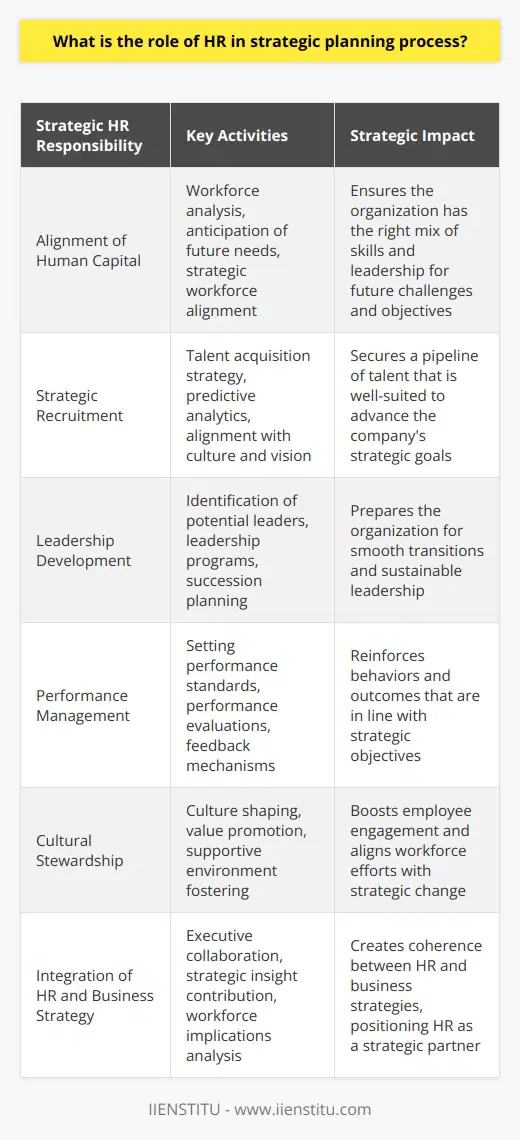
How do the company's HR needs influence strategic planning?
Influence of HR Needs on Strategic Planning
Strategic planning in business is heavily influenced by the company's HR needs. Essentially, these needs help determine the company's future actions, goals, and methods of achieving them.
Identifying Talent Requirements
Identification of the required skills and competencies within the workforce is a crucial HR function. This aligns with strategic planning by dictating recruitment, training, development, and retention strategies. Companies must identify the talent needed to fulfill their strategy and build a workforce to achieve those aims.
Influencing Organizational Culture
HR needs can shape the organization's culture, a crucial element in strategic planning. Establishing a strong culture can help employees understand and pursue the company's strategic goals. HR plays a key role by instilling values consistent with the firm's strategic initiatives, such as innovation or customer-service orientation.
Workforce Planning
In addition, strategic planning is unavoidably linked to workforce planning. HR needs determine the number of employees, their roles, and the development opportunities required. Thus, HR needs directly influence budget allocation, growth plans and the potential for company expansion.
Driving Change Management
Furthermore, HR needs drive change management, a vital component of strategic planning. HR ensures employees are prepared for changes in business processes or strategies, mitigating resistance and bolstering success.
In summary, HR needs significantly affect strategic planning. By identifying talent requirements, influencing organizational culture, conducting workforce planning, and driving change management, HR plays an essential role in determining the direction and success of a company's strategic planning.

What is the role of HR manager in manpower planning?
Role Identification
The role of a HR manager in manpower planning is seminal. A HR manager is responsible for identifying the current and future human resource needs within an organization.
Analyzing Current Workforce
They must first analyze their current workforce. They assess the skills and competencies present. Then they identify the gaps that need closing.
Forecasting Future Requirements
Moreover, they forecast future staffing needs based on business strategies, planned projects and anticipated growth. By analyzing this, HR managers can project labor demands.
Developing Plans
Having projected labor demand, HR managers develop recruitment strategies. They map out a pathway to attract the right talent. These strategic plans could involve talent acquisition, employee training, or succession planning.
Ensuring Skills Suitability
HR managers must ensure that staffing plans fit the business strategy. They match the required skills with the right positions. Thereby, they ensure optimum productivity and profitability for the business.
Managing Operational Efficiency
Additionally, HR managers ensure operational efficiency. They work to keep labor costs under control while meeting manpower needs. Careful planning helps avoid unnecessary expenses.
Protecting Lawful Practices
HR managers also ensure lawful practices. They take care of compliance issues in employee recruitment, management and termination. They protect the company from possible lawsuits.
To summarize, the HR manager plays an influential role in manpower planning. The scope is wide, ranging from analyzing current workforces to ensuring operational efficiency, all while maintaining lawful practices. The HR manager's role is critical in aligning an organization's people strategy with its business strategy, ensuring its successful execution.
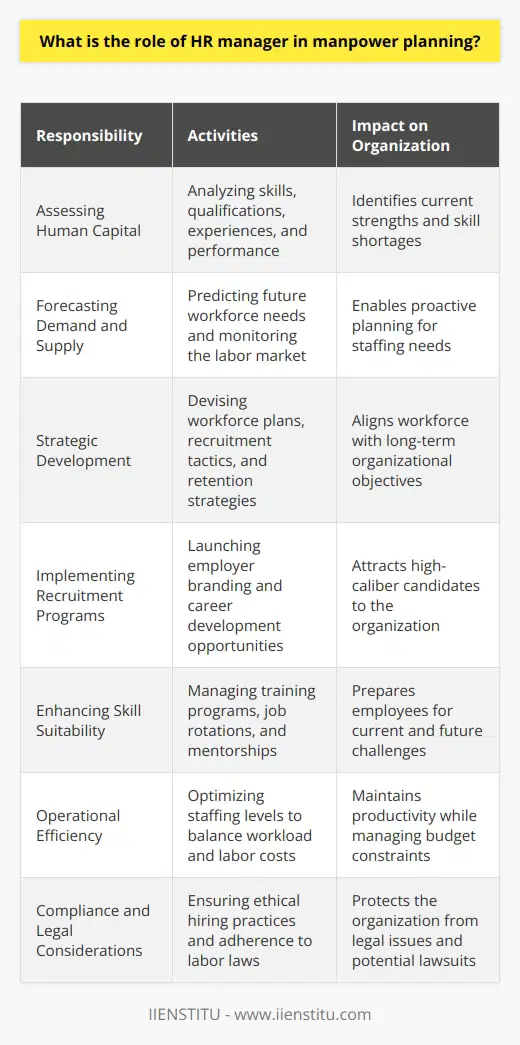
What is the role of human resources management in strategic management?
Role of HRM in Formulating Strategies
Human Resources Management (HRM) plays a critical role in strategic management by aligning the workforce with the company's goals. HRM helps develop a strategic plan to guide employee actions and decisions. It also sets clear performance targets concerning company objectives.
HRM in Determining Strategic Direction
HRM involves analysing skills within the workforce, defining needs, and ensuring the workforce acquires necessary competencies. Employees acquire these competencies through training programs, talent development initiatives, as well as effective recruitment practices. HRM's role thus extends to shaping the talent pool to match the strategic direction of the company.
HRM in Strategy Execution
HRM also executes strategic plans through talent management. HRM links individual efforts to company objectives, ensuring each employee contributes meaningfully to strategic goals. It designs compensation systems, fostering a performance-oriented culture that rewards initiative and execution excellence.
HRM in Fostering Organizational Culture
HRM plays a key role in fostering company culture, a powerful tool in strategic management. A strong, positive culture increases employee engagement, productivity and loyalty. HRM helps shape this culture through effective communication, promoting company values, and tackling workforce challenges proactively.
HRM in Change Management
In each strategic shift, HRM plays the valuable role of change management. It prepares employees for change and manages resistance effectively. This role ensures the smooth transition from old strategies to new, minimizing disruptions in company operations.
In conclusion, HRM is crucial in strategic management. It helps formulate strategies, align the workforce with company goals, and manage change effectively. Consequently, companies that leverage HRM in strategic management can expect improved performance and competitive advantage.

How do HR leaders ensure the alignment of employee learning and development initiatives with the organization's strategic priorities?
Identification of Strategic Priorities
HR leaders start with identifying the organization's strategic priorities. They involve executive management to assess business needs and establish goals.
Analyzing Employee Capability
Next, they analyze current employee capabilities against these priorities. They evaluate skills, knowledge, and abilities currently available within the organization.
Development of Learning Initiatives
Based on this analysis, HR then designs learning and development (L&D) initiatives. The initiatives aim to develop or strengthen skills that are crucial to meet strategic goals.
Alignment of Initiatives with Priorities
These initiatives are then aligned with strategic priorities to ensure relevancy. This alignment ensures that the L&D initiatives are not just random but rather focused on the specific needs of the organization.
Communication of Objectives
Furthermore, HR communicates these objectives and their linkage to strategic priorities. They do this to make staff understand the reasons behind the learning initiatives.
Feedback and Continuous Improvement
Lastly, HR adopts a continuous improvement approach. They invite feedback from employees and monitor the effectiveness of these initiatives. It allows adjustments of L&D initiatives as necessary, ensuring they stay aligned with strategic priorities.
In conclusion, HR leaders play a vital role in aligning employee learning and development initiatives with an organization's strategic priorities. By doing so, they ensure that resources invested in L&D provide strategic value to the organization.

In what ways do HR professionals contribute to the continuous improvement of organizational processes and capabilities within the context of strategic planning?
Acquisition of Talent
HR professionals contribute to the improvement of organizational processes and capabilities by acquiring competent talent. They do this by strategically attracting, selecting, and retaining employees who align with the organization's goals and culture. The HR team ensures the right individuals are in the right roles, which is key to enhancing organizational effectiveness.
Employee Development
Another way HR enhances organizational capabilities is through continuous education and development initiatives. They create training programs that help employees acquire new skills and knowledge. This increases employees' performance, leading to improved productivity and efficiency. Additionally, HR organizes career development programs, enabling employees to progress and contribute more to the organization.
Sustaining Employee Morale
HR also plays a significant role in boosting employee morale. Happy employees are more likely to perform better and stay with the company. To ensure this, HR formulates policies that aim at promoting a positive work environment, such as fairness in rewards, motivation, and conflict management.
Change Management
Moreover, HR participates in strategic planning through effective change management. When an organization decides to implement new strategies, HR ensures a smooth transition. This involves communicating changes, managing resistance, and facilitating acceptance among employees. Hence, HR brings stability during uncertain times.
Strategic Alignment
Lastly, HR aligns human resources with strategic goals. It involves integrating HR strategies with business strategies. This includes developing staff competencies that match organizational objectives, thereby improving overall capability.
In conclusion, HR professionals play a vital role in the continuous improvement of organizational processes and abilities. Their involvement in talent acquisition, development initiatives, morale boosting, change management, and strategic alignment makes them key contributors in strategic planning.
